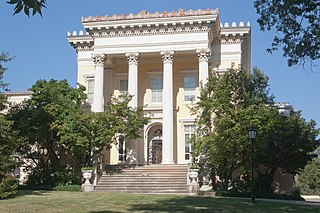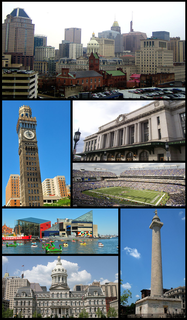
Daniel Coit Gilman was an American educator and academic. Gilman was instrumental in founding the Sheffield Scientific School at Yale College, and subsequently served as the third president of the University of California, as the first president of Johns Hopkins University, and as founding president of the Carnegie Institution. He was also co-founder of the Russell Trust Association, which administers the business affairs of Yale's Skull and Bones society. Gilman served for twenty five years as president of Johns Hopkins; his inauguration in 1876 has been said to mark "the starting point of postgraduate education in the U.S."

Homewood Field is the athletics stadium of the Johns Hopkins University in Baltimore, Maryland. It was built in 1906 and has an official capacity of 8,500 people. The name is taken, as is that of the entire campus, from the name of the estate of Charles Carroll of Carrollton. Homewood Field is located on the northern border of the campus, and it is adjacent to the U.S. Lacrosse Hall of Fame. It serves as the home field for the university's football, soccer, field hockey and lacrosse teams.

Milton Stover Eisenhower was an American educational administrator. He served as president of three major American universities: Kansas State University, Pennsylvania State University, and Johns Hopkins University. He was the younger brother of U.S. President Dwight D. Eisenhower.

The Peabody Institute of The Johns Hopkins University (JHU) is a conservatory and university-preparatory school in the Mount Vernon-Belvedere neighborhood of northern Baltimore, Maryland, United States, facing the landmark Washington Monument circle at the southeast corner of North Charles and East Monument Streets.

The Johns Hopkins University Press is the publishing division of Johns Hopkins University. It was founded in 1878 and is the oldest continuously running university press in the United States. The Press publishes books, journals, and electronic databases. Considering all its units it is a contender for America's largest university press. Its headquarters are in Charles Village, Baltimore.
The Zanvyl Krieger School of Arts & Sciences, located in Baltimore, Maryland, is one of nine academic divisions of the Johns Hopkins University, in the United States. Located at the university’s Homewood campus at the Charles Village neighborhood in northern Baltimore. It is the core institution of Johns Hopkins, offering comprehensive undergraduate education and graduate training in the humanities, natural and social sciences. Notably, the French department was recognized as a "Center of Excellence" in the study of French culture and language by the government of France, one of only six in the United States. The Writing Seminars department, a program in creative writing, was ranked second-best in the nation by U.S. News & World Report. The school is named in honor of Zanvyl Krieger.

The Homewood Museum is a historical museum located on the Johns Hopkins University campus in Baltimore, Maryland. It was listed as a National Historic Landmark in 1971, noted as a family home of Maryland's Carroll family. It, along with Evergreen Museum & Library, make up the Johns Hopkins University Museums.

Evergreen Museum & Library, also known as Evergreen House, is a historical museum of the Johns Hopkins University in Baltimore, Maryland, United States. It is located between the campuses of the Notre Dame of Maryland University and Loyola College. It, along with Homewood Museum, make up the Johns Hopkins University Museums.
The George Peabody Library, formerly known as the Library of the Peabody Institute of the City of Baltimore, is the 19th-century focused research library of The Johns Hopkins University. It is located on the Peabody campus at West Mount Vernon Place in the Mount Vernon-Belvedere historic cultural neighborhood north of downtown Baltimore, Maryland, across from the landmark Washington Monument. The collections are available for use by the general public, in keeping with the famous Baltimorean merchant/banker/financier/philanthropist George Peabody's goal to create a library "for the free use of all persons who desire to consult it."
Ayers Saint Gross, Architects and Planners is an architectural firm in Maryland, U.S. specializing in master plans and building designs for higher education institutions. The firm is described as maintaining “a narrower focus on college and university work than any other in the country.”

The Johns Hopkins Blue Jays men's lacrosse team represents Johns Hopkins University in National Collegiate Athletic Association (NCAA) Division I college lacrosse. Starting in 2015, the Blue Jays have represented the Big Ten Conference.

The Johns Hopkins Blue Jays women's lacrosse team represents Johns Hopkins University in the National Collegiate Athletic Association (NCAA) Division I women's college lacrosse competition. The Blue Jays play their home games at Homewood Field located on the school's Homewood campus in Baltimore, Maryland.
Instances and mentions of Johns Hopkins University in popular culture.

The Homewood campus is the main academic and administrative center of the Johns Hopkins University. It is located at 3400 North Charles Street in Baltimore, Maryland. It houses the two major undergraduate schools: the Zanvyl Krieger School of Arts and Sciences and the Whiting School of Engineering.

The Johns Hopkins Outdoors Club (JHOC) is a student organization devoted to fostering a culture of adventure, environmentalism, and leadership on the Homewood Campus of the Johns Hopkins University in Baltimore, MD. Founded in 1972, JHOC is one of the oldest student outdoors clubs in the Mid-Atlantic region. Run entirely by undergraduate club leaders, JHOC offers no-cost day and weekend long trips in the areas of caving, backpacking, hiking, canoeing, rock climbing, and mountain biking to Hopkins students.
The Johns Hopkins University Department of Biomedical Engineering has both undergraduate and graduate biomedical engineering programs located at the Johns Hopkins University in Baltimore, Maryland,
















